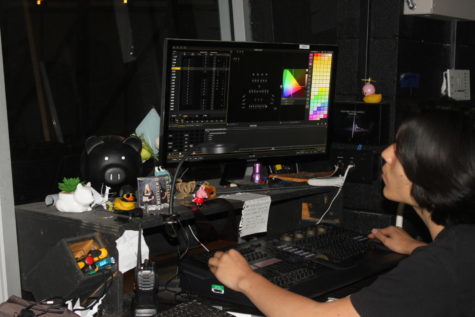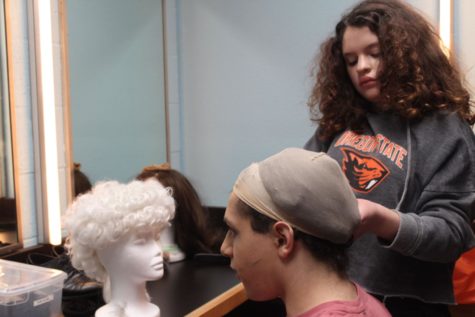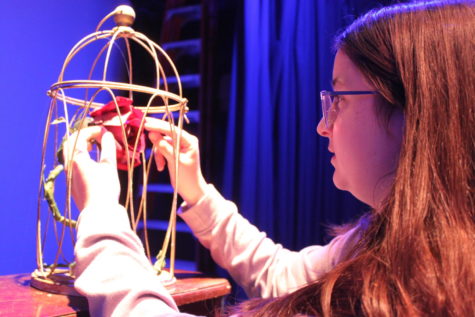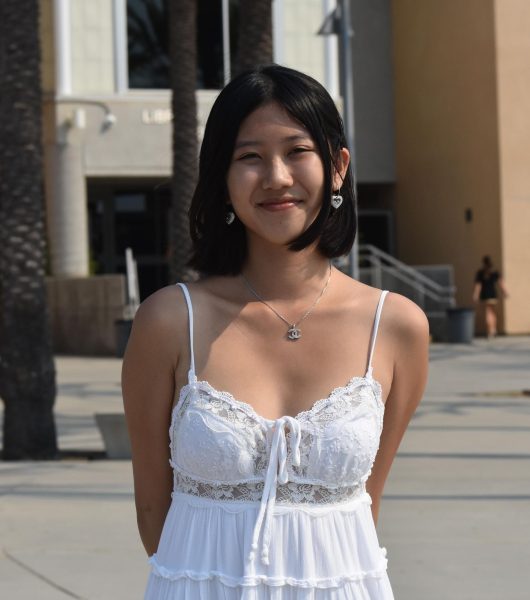Behind the Curtain: An in-depth look into theater’s backstage crew
April 7, 2023
Lighting:

In contrast to the dark room that Thomas Hurd (12) sat in, the stage in front of him was lit with vibrant colors. He watched Beauty and the Beast unfold in front of him, his lighting controls playing a subtle yet essential part in the show coming to life.
The process for creating these color queues had begun months before. Hurd said that his first step as a co-designer was to look through the show and find places where lighting could go.
“We take a look at blocking and what’s happening on stage,” he said. “We want to light that accordingly.”
The next step, after getting a rough idea, is to begin adding signals to the scripts for the colors they are going to use, what parts of the stage it will light up, and when it changes.
“Once we get our scripts, we go through and start adding queues,” Hurd said. “And once the actors are ready, we will go scene-by-scene during rehearsals to create a whole lighting plot that we will use during the show as reference.”
It is essential, Hurd says, to adjust the lighting to each scene to evoke different moods within the viewers.
“Lighting is supposed to be very subtle and show different emotions, empathizing [the audience] with the acting,” he said.
“Like, for a lot of the castle scenes, it’s very blue, making it more cool-toned. While, for a lot of town scenes out of the castle, it’s yellow and that gives the audience a more happy feel.”
He adds that for the more excessive and dramatic scenes, lighting can really make a difference in setting the tone for the play.
“And for exaggerated and emotional scenes, we really want to put those vibrant colors,” Hurd said. “I use lots of reds and lots of downlighting, so there is a lot of shadow on their faces. It shows how violent the scene is, especially when the beast gets stabbed.”
However, even with all this planning and practice, during performances, the lighting script can still be adjusted to work better.
“We are constantly changing things,” Hurd said. “We have to be ready, even during the show, to change things last-minute. The job can be quite stressful.”
Hair and Makeup:

In middle-school, Lindsay Butman (10) sat in the back of the theater, having been dragged by her family to support her sister in the production of The Addams Family. She slouched in her seat as the curtains opened, unsure if she would like the show or not. However, as the actors came into view, her eyes widened, lighting up, and she shot straight up in her seat. She couldn’t look away.
“As soon as I saw all the wigs and makeup, I knew that was exactly the position I wanted to do,” Butman said. “The whole musical I was just in absolute awe.”
Years later, she finally achieved her dream. Entering her sophomore year, she was assigned the position of “Head of Hair” and on the current set of Beauty and the Beast, hair plays a large role in the magical allure of the show.
The first step to adapting these characters is creating a distinct style, taking elements nostalgic to Beauty and the Beast and translating them into a stage format.
“There are amazing designers who create mental images of what they want for this show,” she said. “I find wigs that we either already have or wigs to buy, then I see what I can do to fit the character and the design. It’s my job to make sure that their vision becomes a reality.”
Adjusting, attaching, and shaping the wig to fit the show’s vision is Butman’s most important task.
“For the Beast’s entire hair and makeup look, it takes a lot of time, effort, and bobby pins because there is a very distinct line between messy [for the Beast’s appearance] and can’t see the actors’ face,” she said. “For the nose, we have a spirit gum prosthetic, our lovely crew members do wolf-like makeup all over his face, crepe wool to create a scraggly beard, and then the beast horns.”
Butman’s job doesn’t end there. During the show, she always has to be on standby to do hair adjustments and make sure everything is staying in place. The most difficult part of her job in this show, however, is the Beast’s transformation to a prince, in which the entire department has to rush to get it done on time. However, Butman enjoys the process.
“My favorite part of this job is actually the adrenaline and then the feeling of success that comes from all our hard work,” she said. “When the quick changes [like the Beast’s transformation] go really well we all get so proud and celebrate backstage.”
Overall, Butman wouldn’t trade her job for the world.
“It is such an amazing experience,” Butman said. “Even the pressure and adrenaline is just a part of the job that I know and love.”
Props:

Shira Ehrlich (11), the props designer and one of the assistant directors for Beauty and the Beast, never initially thought she would work behind the scenes. Her dream was to be onstage, but once she inherited the position, Ehrlich said she realized her passion for the role.
“Imagine a show without the props,” Ehrlich said. “What if there wasn’t a rose in Beauty and the Beast? No books for Belle to read? No magic mirror? The objects people hold and interact with onstage have more meaning than meets the eye, and can be a small but crucial part of the story.”
To Ehrlich, her process for designing is centered around the importance of creating a visual beforehand that can really bring the show to life.
“To create a prop, the first step is usually to look for inspiration,” she said. “After that I create a sketch and collaborate with our technical director, Clint Webster, to figure out the mechanics of any props that need to move or have a real function.”
The next step would be to look for materials to bring her idea to life. Ehrlich said that some props can be bought, like the magic mirror for Beauty and the Beast, but it can take weeks to find the perfect one. Others, however, have to be made from scratch. Creativity, she said, is essential for this process.
“I made the falling duck [in Beauty and the Beast] using a dog toy and filling it with sand,” she said. “The best example, though, of course, is the rose. I came up with a plan to get the petals to fall on command with the help of our technical director. I then hand-made the rose using wire, floral tape, floral foam, fishing line, and parts of a fake rose that I took apart and put back together.”
She said the rose, one of her more complex props, took her nearly five hours to create. Even after it was finished, she had to make adjustments, depending on changes that were made by set, lighting, and the direction of the production.
“One thing I’ve learned as a designer is that designs should always be flexible and adaptable to change,” she said.
The props for Beauty and the Beast are just a few of the many props she has made. Ehrlich hopes to continue designing.
Costume:
Amanda Sasher (12) watched intently backstage as Katie Ditter (11), the actor for Belle, glided onto the set of Beauty and the Beast. Her aureate ball gown shimmered under the bright stage lights as her skirt swayed back and forth. Sasher smiled.
Belle’s dress was just one of the many costumes that Sasher had made throughout her high-school career as the theater’s costume designer. Her process started with using the script as well as other versions of the Beauty and the Beast story as a foundation for how she wanted to approach her designs.
“I just basically go through the script as soon as we get it and envision a basic design for each of the characters’ costumes,” she said. “For Beauty and the Beast, I also looked at the movie and listened to the soundtrack. Sometimes, I sketch it out, but I’m not really an artist, so most of it is in my head and I work with the crew to bring it to life.”
Sasha Levy (10), the costume crewhead, is in charge of the logistics of the costume creation and usage within the show. Most costumes are usually made from scratch in each production, Levy said; therefore, having the proper materials is essential.
“We have quite a collection of fabric already in the costume room,” Levy said. “But, usually if we need specific fabric or other materials we’ll go to fabric stores like Joann or even thrift pieces of clothing.”
From here, Sasher said the next step is to lay out patterns for her sewing. These patterns are like pieces of the puzzle that help her put together the full costume.
“Some patterns I create by myself,” she said. “Others, I either take patterns I already have from home or we go to the fabric store and buy them. I usually make alterations to the patterns as needed.”
Sasher, then, was ready to begin creating Belle’s golden yellow ballgown..
“After I figured out the full design, had the fabric I needed, and got the actress’s measurements, I began to sew,” Sasher said. “For her ballgown skirt, I got a really big rectangle pattern and I gathered it up to make a big skirt. I did this with the overlay [for the skirt] too. And then for the big poofy part, I used the same rectangle pattern with even increments and I gathered those at the bottom to make it poofy. It took me around a week.”
After the basic dress is completed, the actor then tries the costume on, and further adjustments are made throughout practices, dress rehearsals, and even the show itself. At this point, Levy takes charge of making sure everything is prepared and functioning.
“Most of my job is ensuring that actors have everything for their costumes before and during performances,” Levy said. “I also stay backstage during shows to help actors with any quick changes they may have, like when they have different costumes to wear in scenes that are close together, or if their costume is difficult to put on.”


